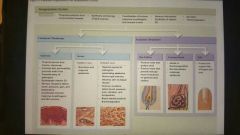![]()
![]()
![]()
Use LEFT and RIGHT arrow keys to navigate between flashcards;
Use UP and DOWN arrow keys to flip the card;
H to show hint;
A reads text to speech;
17 Cards in this Set
- Front
- Back
|
The integumentary system is composed of |
Skin hair nails sweat glands oil glands mammary glands |
|
|
Cutaneous membrane |
Epidermis. Dermis. |
|
|
Integumentary system |

|
|
|
Detainees membrane |

|
|
|
There are four cell types found in the epidermis |
Keratinocytes. Produces tough protein called keratin . Melanocytes. Pigment cells located deep in the epidermis they also produce melanin which is responsible for skin color . Merkel cells. Are sensory cells. And langerhans cells. Wandering macrophages. |
|
|
Layers of epidermis. Come let's get sun burned |
Corneum. Lucidum. Granulosum. Spinosum. Basale. |
|
|
Stratum basale |
Location of melanocytes. Cells in this area are undergoing active reproduction. |
|
|
Stratum spinosum |
Keratinocytes are bound together by desmosomes. |
|
|
Stratum granulosum |
Keratinocytes produce lots of keratin |
|
|
Stratum corneum |
Superficial layer consists of interlocking dehydrated dead cel |
|
|
Epidermal pigment content |
Carotene derive from carrots corn and squash. Can convert to vitamin A. Melanin. Produced and stored and melanocytes crates night natural skin color and tan. |
|
|
Exposure to UV light melanocyte |
Repeated exposure to UV light can result in long-term epidermal and dermal damage. Results in premature wrinkling. Can result in epidermal skin cancer. |
|
|
The dermis consists of two layers |
Popular layers. Which is The Superficial dermis. And the reticular layer which is the Deep dermis. |
|
|
Papillary layers consist of |
Loose connective tissue. Dermal papillae. Capillaries. Nerve axons. |
|
|
Reticular layers consist of |
Interwoven network of dense irregular connective tissue. Hair follicles. Sweat glands. Sebaceous glands. |
|
|
Why do we get wrinkles |
The interwoven collagen fibers provide tensile strength the elastic fibers allow the skin to stretch and recoil but skin wrinkles are due to age change of hormone levels and UV light |
|
|
Stretch marks and why we get them |
Extensive stretching during pregnancy excessive waking can cause reticular fibers to break. The skin does not require. The skin wrinkles and creases result in stretch marks. |

